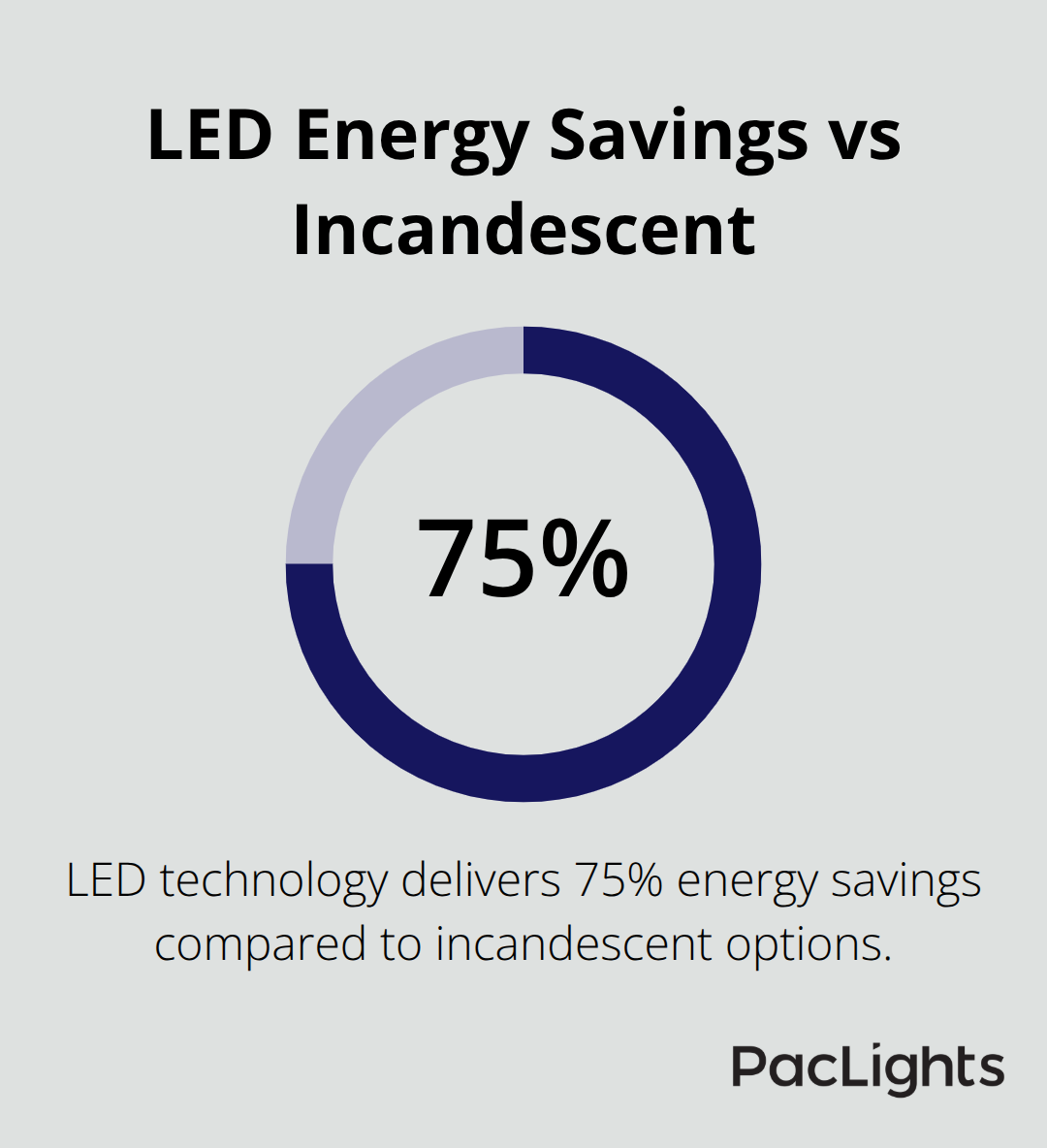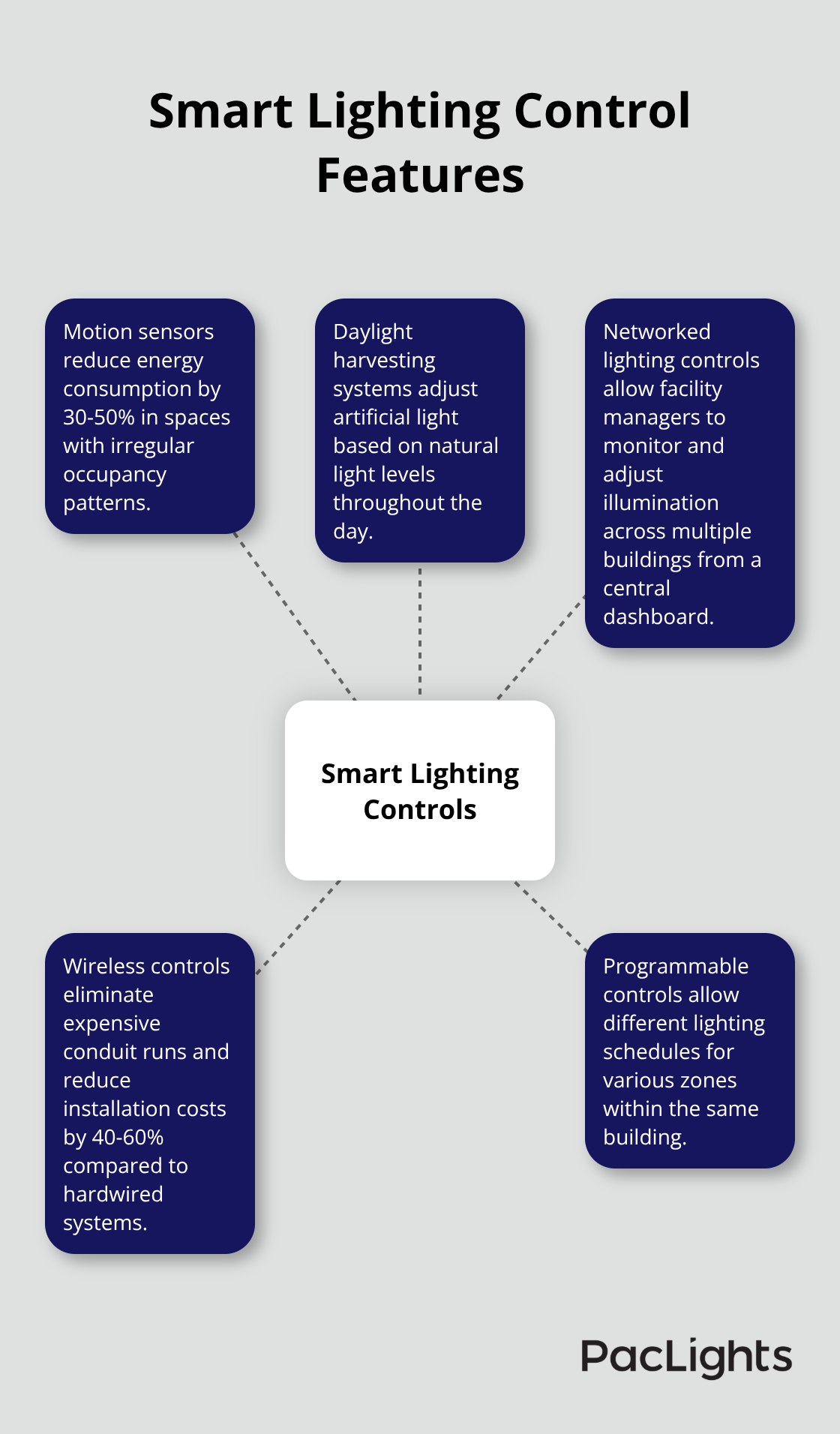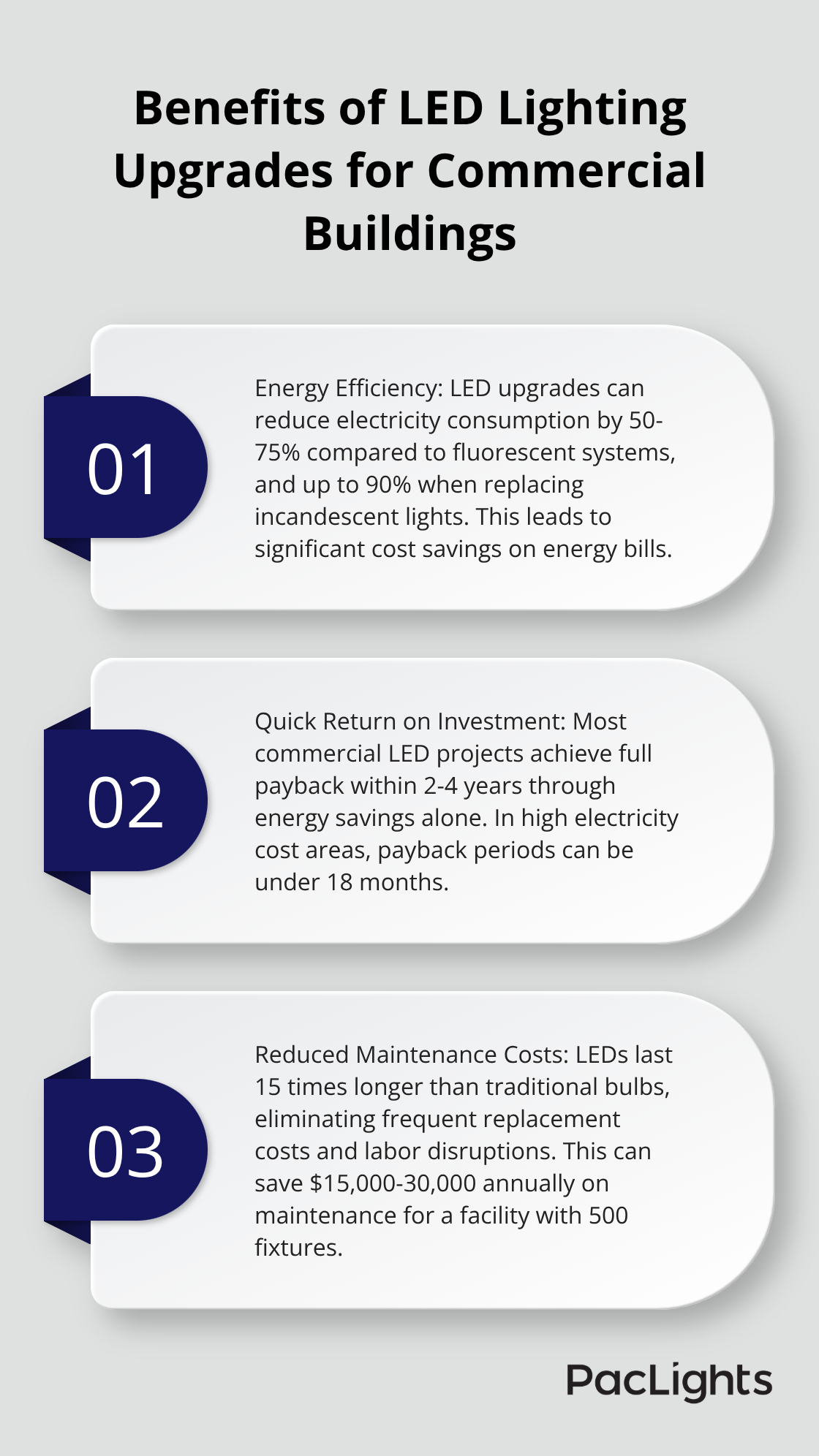Commercial building lighting fixtures directly impact your energy costs, employee productivity, and customer experience. Poor lighting choices can increase operating expenses by 30-40% annually.
We at PacLights help businesses select the right lighting solutions for their specific needs. This guide covers fixture types, key selection criteria, and cost analysis to optimize your commercial lighting investment.
Which Commercial Lighting Fixtures Work Best
Commercial lighting fixtures fall into three distinct categories that address different operational needs. Indoor fixtures handle office productivity and retail sales environments. Outdoor fixtures manage security and safety for building perimeters. Specialty fixtures serve unique industrial applications where standard lighting fails.
Indoor Commercial Lighting Solutions
Office spaces need troffer lights and flat panel lights that deliver 30-50 foot-candles for general tasks. Linear strip lights work best in warehouses where ceiling heights exceed 20 feet. Recessed down lights create focused illumination for retail displays (studies show sales increases up to 15% with proper retail lighting). High bay fixtures handle industrial facilities with ceilings above 25 feet and provide uniform light distribution across large floor areas. Each fixture type serves specific ceiling heights and task requirements that standard residential lighting cannot meet.
Outdoor Building Lighting Options
Parking areas need area lighting fixtures mounted 15-35 feet high depending on lot size. Wall lights provide building perimeter security with minimum 10 foot-candles at ground level. Canopy lights protect gas stations and loading docks from weather while they maintain bright work conditions. Flood lights illuminate building facades and signage for visibility and brand recognition. Parking garage lights require vapor-proof construction to handle moisture and temperature changes that damage standard fixtures.
Specialty Industrial Applications
Sports facilities demand specialized fixtures that eliminate shadows and glare for player safety. Roadway lights require precise light distribution patterns that meet municipal safety standards. Highmast lights cover large areas like airports and shipping yards from heights up to 150 feet. Vapor proof and hazardous location lights handle chemical plants and manufacturing environments where standard fixtures create safety risks (these applications require specific certifications and construction standards).
The right fixture selection depends heavily on energy efficiency ratings, control capabilities, and maintenance requirements that affect your total cost of ownership.
What Features Matter Most When Choosing Commercial Lighting
Energy efficiency stands as the most important selection criterion for commercial lighting fixtures. LED technology delivers 75% energy savings compared to incandescent options and lasts 25 times longer according to the Department of Energy. Traditional incandescent bulbs waste 90% of energy as heat while LEDs produce minimal heat output. The widespread adoption of LEDs could reduce U.S. electricity consumption equivalent to 44 large power plants by 2027, which saves over $30 billion annually. These numbers make LED retrofits the only smart choice for cost-conscious businesses.

Smart Controls Drive Additional Savings
Advanced lighting controls amplify LED efficiency gains through automated operation. Motion sensors reduce energy consumption by 30-50% in spaces with irregular occupancy patterns. Daylight harvesting systems adjust artificial light based on natural light levels throughout the day. Networked lighting controls allow facility managers to monitor and adjust illumination across multiple buildings from a central dashboard. Buildings with occupancy sensors and automated controls typically see 20-30% additional energy savings beyond basic LED upgrades.
Durability Requirements Vary by Application
Fixture construction determines maintenance costs and operational reliability over time. Vapor-proof fixtures handle moisture in parking garages and food processing facilities where standard fixtures fail within months. Hazardous location fixtures meet safety certifications for chemical plants and manufacturing environments (these applications require specific certifications and construction standards). Industrial fixtures need impact-resistant housings and vibration-resistant components for warehouse and factory applications. Quality commercial fixtures should provide 50,000-hour lifespans with minimal maintenance requirements that reduce labor costs and business disruptions.
Control Integration Affects Total Cost
Modern commercial facilities require lighting systems that integrate with building management platforms. Wireless controls eliminate expensive conduit runs and reduce installation costs by 40-60% compared to hardwired systems. Programmable controls allow different lighting schedules for various zones within the same building. Smart sensors can detect occupancy patterns and adjust lighting zones automatically throughout the day. These control features become essential when you calculate the total investment required for your lighting upgrade project.

How Much Will LED Upgrades Actually Save You
Commercial LED retrofits require upfront investments that range from $2-8 per square foot based on fixture complexity and building type. Office spaces typically cost $3-5 per square foot while industrial facilities with high bay requirements reach $6-8 per square foot. The Department of Energy reports that businesses who switch from fluorescent to LED systems see electricity reductions of 50-75%, while incandescent replacements deliver savings up to 90%. A 50,000 square foot office that spends $25,000 annually on electricity can reduce costs to $6,250-12,500 after LED installation, which creates annual savings of $12,500-18,750.
Payback Periods Beat All Alternatives
Most commercial LED projects achieve full payback within 2-4 years through energy savings alone. Facilities in high electricity cost areas like California and New York see payback periods under 18 months. Maintenance savings add another layer of value since LEDs last 15 times longer than traditional bulbs, which eliminates frequent replacement costs and labor disruptions.
Rebates Reduce Initial Investment Costs
Utility companies offer rebates up to $249 per fixture through ENERGY STAR programs, which reduces initial investment costs by 20-40%. The Energy Information Administration confirms that inefficient systems account for 17% of commercial electricity consumption (this makes LED upgrades the fastest path to measurable cost reduction). Smart businesses prioritize these retrofits before other energy efficiency projects because the returns are immediate and guaranteed.
Maintenance Savings Compound Over Time
Traditional bulbs require replacement every 1,000-2,000 hours while LEDs operate for 50,000+ hours without failure. This difference eliminates maintenance calls that cost $75-150 per visit including labor and equipment. A facility with 500 fixtures saves $15,000-30,000 annually on maintenance alone after LED conversion. Heat reduction also extends HVAC equipment life and reduces cooling costs by 10-15% in climate-controlled environments.

Final Thoughts
Smart commercial building lighting fixtures deliver measurable returns through energy savings, reduced maintenance costs, and improved workplace productivity. LED technology with advanced controls represents the most cost-effective upgrade path for businesses that seek immediate operational improvements. Most commercial facilities see payback periods under three years with utility rebates that reduce initial investment costs.
The lighting industry continues to evolve toward networked systems that integrate with building management platforms. Motion sensors and daylight harvesting will become standard features rather than premium options. These technologies enable facility managers to optimize energy consumption across multiple locations from centralized dashboards.
Your next step involves a professional lighting audit to identify specific upgrade opportunities. Calculate potential savings based on current electricity costs and fixture replacement schedules (this analysis reveals the true ROI potential for your facility). We at PacLights provide comprehensive lighting solutions to help you make informed decisions about your commercial building lighting fixtures upgrade.


Disclaimer: PacLights is not responsible for any actions taken based on the suggestions and information provided in this article, and readers should consult local building and electrical codes for proper guidance.